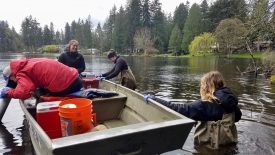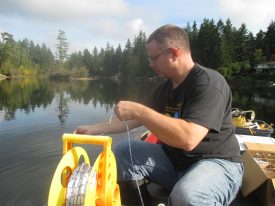by Lisa Hayward
In the early 2000s, when Dr.Jim Gawel started measuring arsenic in lakes with his undergraduates, he wasn’t expecting to see much of it in the water. “Normally, when oxygen is present, arsenic tends to stick to particles and fall out of the water column,” he explained. After that it tends to sit at the bottom in the sediments.
That’s why it came as a surprise when he and the students measured high levels of arsenic in water samples from Lake Killarney. “That was something totally unexpected,” Gawel said. “I thought we must’ve done something wrong.” But when his lab repeated the tests, they found the same results. “It was pretty amazing to find this little lake that broke the rules about what we thought we knew about lake chemistry,” Gawel recalls.
Nothing about Lake Killarney’s appearance would suggest its contamination. According to Gawel, it’s an idyllic pond ringed with houses, favored by waterfowl, and rich with aquatic plants. It’s also situated downwind from the former ASARCO smelter in Ruston, Washington, in a 1,000-square-mile, largely residential area known as the Tacoma Smelter Plume. Aerial transport of lead and arsenic from the former smelter led to widespread contamination in this area and its eventual designation as one of the nation’s first Superfund sites.
When Gawel started his lake sampling program, he was a new hire in the University of Washington (UW) Tacoma’s School of Interdisciplinary Arts and Sciences — in a science program itself so new it didn’t yet have a building. “They gave me a closet to use as a lab,” Gawel remembers. Sampling lake sediment seemed like an easy project to get undergraduates involved in research. “We got a $99 microwave for the digestions,” Gawel explains.
Lake Killarney turned out to have arsenic levels of more than six times the minimum the Washington Department of Ecology identifies as likely to harm sediment-dwelling organisms. Even given the high levels of arsenic in the sediment, finding it in Lake Killarney’s water column was a surprise.

Erin Hull (UWT) takes waypoint for installation site for shallow porewater peeper on Lake Killarney.
Gawel notes two possible explanations. First, Lake Killarney is a relatively small, shallow lake, and shallow lakes are less likely to stratify in summer as larger lakes do. In a larger lake, cold, heavier waters sit at the lake bottom in a layer that doesn’t usually mix with warmer surface waters because of their marked difference in density. This stratification tends to keep arsenic trapped at the bottom of the lake. In contrast, shallow lakes warm up more thoroughly and don’t form separate layers, providing more chance for arsenic in the sediment to become mixed into water throughout the lake.
Second, arsenic is chemically similar to phosphorus—enough so that phytoplankton mistakenly take it up instead of the phosphorus that they need to make their phospholipid membranes. In oxygen-rich water, phytoplankton can take arsenic up so quickly that it doesn’t have a chance to bind particles and settle into the sediment. Instead it enters the food chain as part of the phytoplankton that feed zooplankton, insects, fish, and other organisms.
This phenomenon leads Gawel and his colleagues to wonder whether arsenic in shallow lakes poses a hazard to human health. On the one hand, exposure to arsenic is known to increase the risk of cancer, and people do eat fish from lakes like Killarney. On the other hand, because arsenic is water-soluble, it doesn’t bioaccumulate like fat-soluble mercury or PCBs. Instead it does the opposite, diminishing in concentration as it moves up the food chain. The biggest concern is the level of potential arsenic exposure associated with eating warm water species like the sunfish, crappies and bottom-dwelling crayfish favored by immigrant and/or lower income populations who fish for supplemental food for their families.
To better understand this potential human health risk, Gawel is currently collaborating with Dr. Rebecca Neumann of UW’s Department of Civil and Environmental Engineering. Neumann specializes in hydro-biogeochemistry and studied arsenic in groundwater in Bangladesh for her Ph.D. Gawel and Neumann have also partnered with Dr. Julian Olden of UW’s School of Aquatic and Fisheries Science to sample arsenic in lake fish and crayfish. Olden will begin gill-netting this summer. Gawel and Neumann are also working with Dr. Alex Horner-Devine in UW’s Department of Civil and Environmental Engineering to better understand the chemical and physical transfer of arsenic from sediments to lake water in shallow lakes.
Gawel and Neumann are both principal investigators with the UW Superfund Research Program. They recently published a paper about their work on arsenic in shallow lakes in Science of the Total Environment.
Printed with permission from the University of Washington Department of Environmental & Occupational Health Sciences. Lisa Hayward is a communications manager in the Department of Environmental & Occupational Health Sciences.











